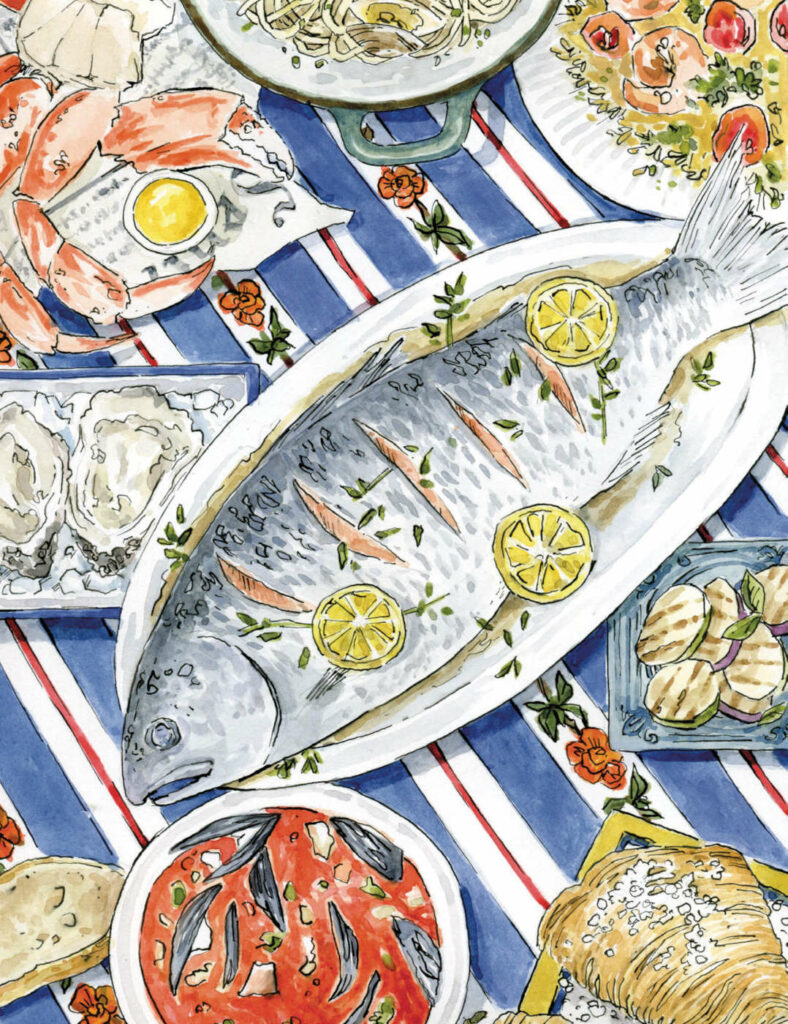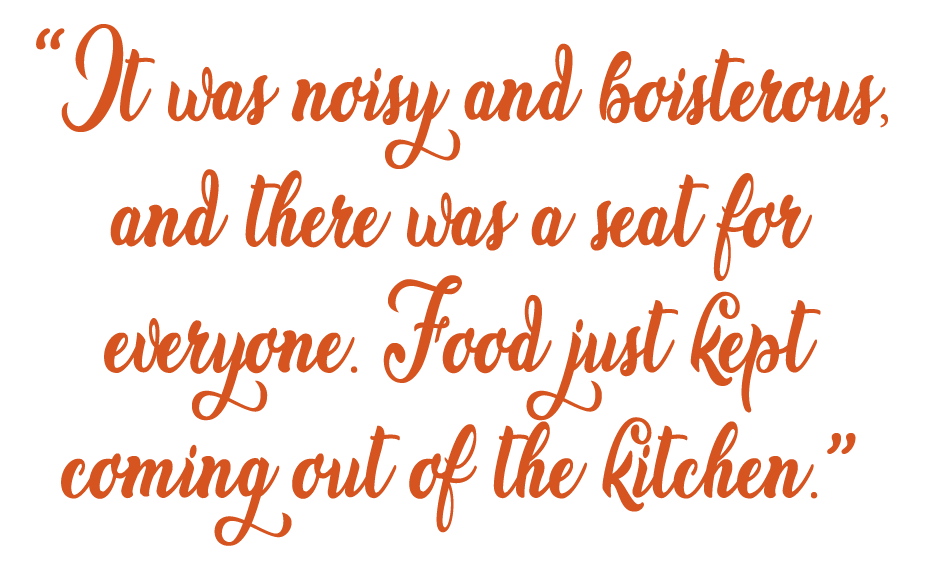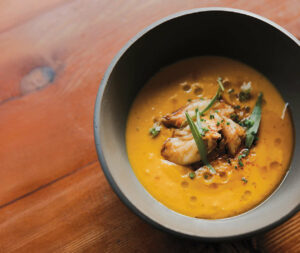
Memories of an Italian-American Christmas Eve
ILLUSTRATION BY TINA FULLER SOMERS
As a teen growing up in Santa Cruz, I used to watch the fishing boats every December sail past the edges of the Monterey Bay and return hours later, their coolers filled with whatever the ocean gave up that day. Perch. Cod. Dungeness crab. Some fishermen caught sardines if there was a mid-winter run. My family would head to the wharf to peruse this bounty, taking home buckets of fish to prepare on Christmas Eve.
While Thanksgiving was a distinctly American celebration in our home, with turkey, stuffing and pumpkin pie, Christmas Eve was all about seafood and Italy. About 1.26 million people in California say they have Italian roots, according to the U.S. Census Bureau. And like many Italian-Americans, including those around the Monterey Bay whose families emigrated from Sicily and southern Italy, my family observed “La Vigilia di Natale,” or the Feast of the Seven Fishes. Ours was a celebration of the coastal culture our Sicilian grandparents left behind and sought to recreate here.
Boiled crabs were cracked over sheets of newspaper. Tomato sauce bubbled on the stove. Chunks of white fish were folded into cioppino. All of it, including the crusty loaves baked in my grandmother’s brick oven, was washed down with tumblers filled with red wine my grandfather stored in jugs in his garage. After our bellies were full, we would change into dresses and suits and head to Midnight Mass.

Theories abound as to why the meal called for seven types of seafood. God created the world in seven days, some people say, and Rome was built on seven hills. Roman Catholics, too, observe seven holy sacraments. (I believe cooking is the eighth. I mean, have you ever tasted a silken marinara perfumed with garlic and oregano?) For most people, though, the number of dishes is only a suggestion. The meal is a touchstone to what is prized in Italian culture: good food and family, whatever that looks like. In a 2023 episode of The Bear, for example, forks fly and pans topple off counters at a Christmas Eve meal gone awry. A 2019 movie (aptly titled Feast of the Seven Fishes) delights in the hijinks of an extended Italian family gathered for one poignant night.
It is no wonder then that I am captivated by this annual tradition. I recently talked with Anthony Carnazzo, who owns the restaurant Stationaery in Carmel-by-the-Sea with his wife, Alissa. Since opening Stationaery in 2018, they have offered a Feast of the Seven Fishes menu for a few nights every December. Carnazzo grew up on Spaghetti Hill in Monterey, a third-generation Italian whose great-grandparents emigrated from outside Catania. He recalled spending Christmas Eve elbow-to-elbow at his grandmother’s table alongside aunts, uncles and a brood of cousins. There, empty plates of antipasti were whisked off the table as soon as they were scraped clean, to be replaced with new ones: grilled calamari, handmade ravioli and crab legs.
“It was beautiful chaos,” said Carnazzo. “It was noisy and boisterous, and there was a seat for everyone. Food just kept coming out of the kitchen.”
For years I have chased this beautiful chaos. In 2013, friends invited me to spend Christmas with them in Rome. I had one request: While the Feast of the Seven Fishes is an Italian-American tradition, I wanted to experience something like it in Rome. So, they took me to Assunta Madre, a restaurant in the Trastevere neighborhood known for its exquisite fish. There, a big-bellied man wearing a black polo shirt stood guard at the front desk. Photos of celebrities, among them Robert DeNiro and Brad Pitt, hung on the walls. Our dinner, it turned out, would be a formal affair, nothing like home where we cracked crab at the kitchen table.
The man who greeted us pointed to several white Styrofoam coolers placed near the front door that were filled with flounder, halibut and tuna. This, he said with a flourish,was the freshest fish we would find in Rome. Ten tables were crammed in the front of the restaurant, with more in back. He seated us upfront. A woman in a black organza gown, her hem spread out like a fishtail, sashayed past us, a baby in her arms. “I can’t believe she just had a baby,” said my friend in awe. Another woman wore a mink stole and red gown that was so long it trailed two inches behind her. Her neck and arms were wrapped in enormous pearls, like a mermaid washed up from the sea to our table.
Dinner came in courses, starting with oysters and a plate of tuna tartar so fresh it dissolved in the mouth. It was followed by seafood risotto and a grilled whole fish, which our server had fetched from one of the Styrofoam boxes and showed us before whisking it away to the kitchen. Next came grilled zucchini and sliced eggplant, and a salad of arugula and tomatoes we barely touched because we were so full. Our waiter demanded we have dessert. He brought us a plate with panettone, nougat and a dense sponge cake drizzled with chocolate.
Carnazzo said Stationaery experimented with a formal menu its first year, but has opted instead for the homey eat-what-you-want plates of his youth. There is always crab on the menu. And in years past, the restaurant’s chef, Amalia Scatena, who studied cooking in Florence, has served spaghetti with clams; Monterey spot prawn with tomatillo, lime and cilantro; and a root vegetable and apple soup with Dungeness crab and brown butter. (See recipe below)
In 2016, a few years after my Roman sojourn, I decided to create a Feast of the Seven Fishes of my own that was worthy of both my childhood and our Italian banquet. I was living in Manhattan then and, because New York has a large Italian-American population, I knew authentic ingredients would be easy to find. I took the subway to Arthur Avenue, New York’s Little Italy in the Bronx, for hand-dipped ricotta and imported cheeses. I bought a whole salmon that I stuffed with herbs I grew on my rooftop. For the pasta course, I tossed shrimp, calamari and Long Island scallops with tomatoes. Anchovies gave the Caesar salad dressing tang. For the antipasti, I roasted eggplant, tomatoes and olives. As you might imagine, there was fresh crab too.
Like at Assunta Madre in Rome, the meal was a formal affair, with a printed menu describing each dish. But the atmosphere was relaxed because my friends and I were at home. Italian Christmas carols played on the stereo. We toasted and shouted “buon natale” between every course. Most of my guests had never eaten a feast like this. A neighbor, curious after hearing so much laughter, knocked on the door, a bottle of wine in hand. He was just in time for dessert.
Over the course of two weeks, I had crisscrossed Manhattan in search of the perfect sfogliatella, a delicately layered Italian pastry shaped like a clam shell and stuffed with sweet ricotta filling. After visits to several bakeries, I brought home a dozen from Veniero’s, an East Village institution founded in 1894 and where Frank Sinatra used to buy his pastries too.
As I opened the box, I realized that I had served only six types of seafood that night. Oh no, I thought. Then I looked at the sfogliatella, the ribs of their crisp shell echoing the ridges of a brown and cream-colored cockle.
Sure, it wasn’t real shellfish. But didn’t it count if it looked like it anyway?

About the author
Laura M. Holson is an award-winning feature writer who worked for The New York Times for more than two decades and founded The Box Sessions, a creativity company. She has traveled extensively within Italy, including Sicily where she visited the villages where her grandparents were born.
- Laura M. Holsonhttps://www.ediblemontereybay.com/author/lauramholson/


